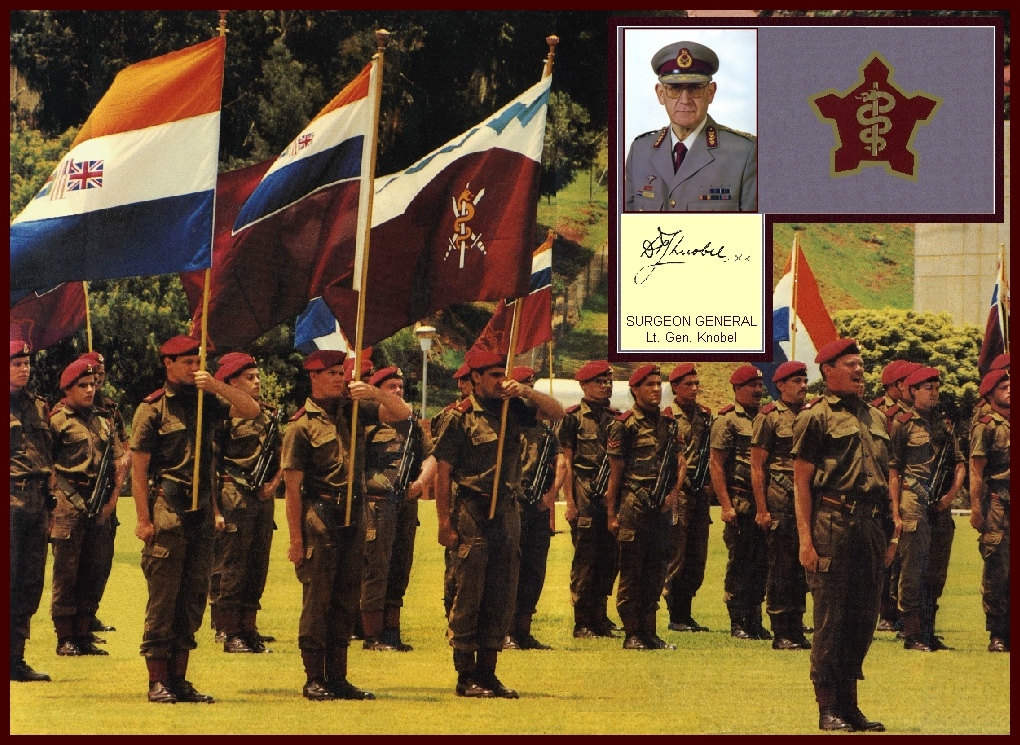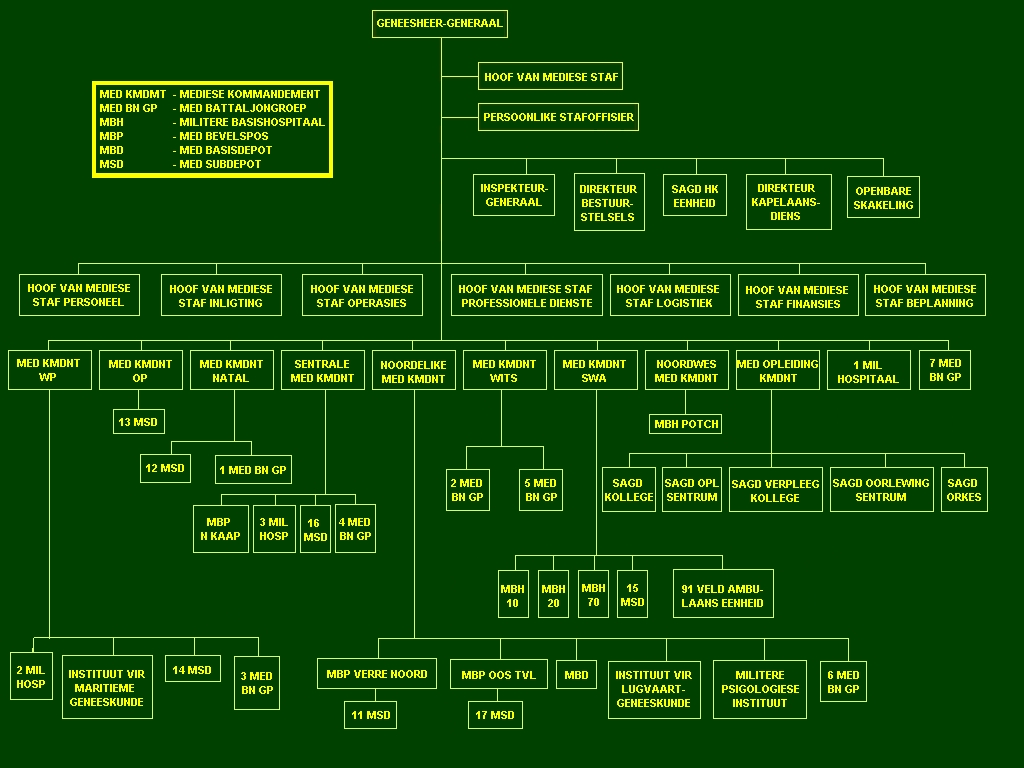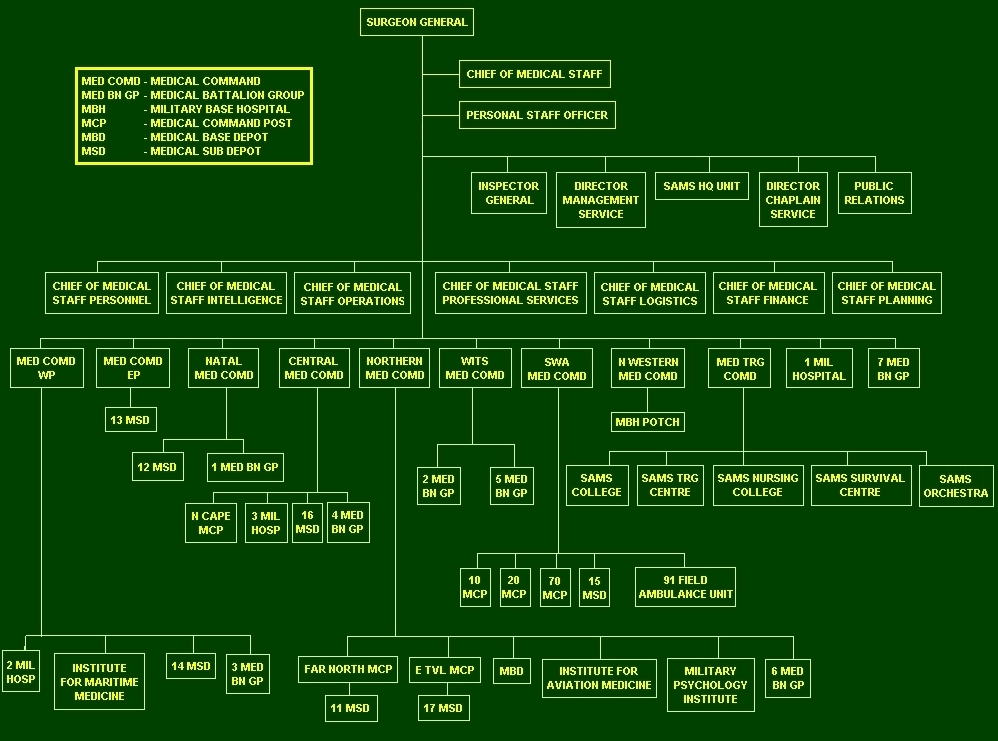|
|
||||||||||
|
 | ||
|
As Lid van die SA Geneeskundige Diens, onderneem ek hiermee:
| ||
|


|
SUID-AFRIKAANSE GENEESKUNDIGE DIENS Inleiding Die moreel van die Suid-Afrikaanse magte is hoog. Een van die belangrikste faktore wat hiertoe bydra, is die Suid-Afrikaanse Geneeskundige Diens (SAGD). Die SAGD verskaf die nodige mediese en verwante dienste vir die SAW in land, lug en seewaartse operasies, en daarby voer hy ook sy eie voorgeskrewe operasionele take uit. Die SAGD voorsien ook omvattende geneeskundige steun aan alle Staandemaglede en hulle afhanklikes asook aan dienende Burgermaglede, dienspligtiges, en lede van die kommando's. Die SAGD volg 'n multi-dissiplinere benadering en sy personeel verteenwoordig meer as 50 erkende mediese en para-mediese professies. Personeel Die SAGD bestaan uit 'n Voltydse en 'n Deeltydse Mag. Die Voltydse Mag bestaan uit professionele manne en vroue wat Staandemaglede is, asook dienspligtiges. Diegene met die nodige kwalifikasies kan in hulle onderskeie beroepe dien na voltooiing van hulle basiese militere orienteringskursus. Die Deeltydse Mag sluit lede van die Burgermag en Kommandomageenhede dwarsoor die land in. Om te verseker dat die beskikbare mediese en verwante dienste so omvattend moontlik is en dat dit op die hoogste professionele vlak bly, stel die SAGD prominente privaat spesialiste as konsltante aan om sy voltydse sterkte van spesialiste aan te vul. Die SAGD word in verskeie organisasies met mediese verbintenisse verteenwoordig. 'n Bydraende faktor is die Geneesheer-generaal se lidmaatskap van die Advieskomitee oor Nasionale Gesondheid en die SA Geneeskundige en Tandheelkundige Raad. Die SAGD bly op hoogte van die talle nuwe mediese produkte op die mark veral deur volgehoue kontak met verskeie verteenwoordigers van mediese maatskappye en deur die evaluering van die doeltreffendheid van hierdie produkte by die Mediese Basisdepot. Die WNNR en Krygkor verskaf ook, op versoek van die SAGD, waardevolle wetenskaplike en tegnologiese inligting om te voorsien in die behoeftes wat die SAGD in operasies en elders mag he. Die SAGD Verpleegkollege is 'n instelling wat by die Suid-Afrikaanse Raad op Verpleging geregistreer is. Verpleegopleiding sluit 'n vierjaar diploma in wat in samewerking met die Universiteit van Suid-Afrika aangebied word en uiteindelik lei tot professionele status in verpleegkunde, Algemene, Psigiatriese en Gemeenskapsverpleegkunde en Verloskunde. Ander opleidingskursusse vir ingeskrewe verpleegkundiges sowel as 'n opleidingskursus van ses maande vir verpleegassistente word ook aangebied. Beurse word aan tandheelkundige en mediese studente beskikbaar gestel. Vir nagraadse studies het hul ook toegang tot die fasiliteite van die Universiteite van Pretoria, Stellenbosch en die Oranje-Vrystaat. Akademiese status is deur die S A Geneeskundige en Tandheelkundige Raad aan verskeie afdelings van die drie militere hospitale toegeken. Die SAGD trek voordeel uit hierdie reeling, aangesien 'n arbeidsmag van kliniese assistente in verskeie spesialiteite tot sy beskikking gestel word. Die militere welsynsdiens bevorder die gesonde sosiale funksionering van die SA Weermag se lede en hulle gesinne met die basiese aanname dat die beste soldaat een is wat goed aangepas is en geen gesins of ander sosiale probleme ondervind nie. Die funksie van die veeartsenyseksie is die voorkoming van die uitbreek en verspreiding van siektes onder SAW se diere, veral perde en honde, en om hulle dienooreenkomstig te behandel. Dit sluit ook die beheer in van siektes soos hondsdolheid in gebiede waar die SA Weermag ontplooi is. Veeartse onderneem ook uitgebreide navorsingsprogramme waarin die bruikbaarheid van spesies getoets en die beste voedingsamestelling in spesifleke toestande bepaal word. 'n Oorlewingsentrum verskaf opleiding aan lugbemanningslede van die SA Lugmag en ander gekeurde militere personeel. Die kursus sluit oorlewingstegnieke in beboste, woestyn en kusgebiede in en is gebaseer op die aanname dat 'n man met slegs sy uniform en 'n mes moet oorleef in enige moeilike toestande wat die natuur en 'n moontlike vyand mag oplewer. Spesiale opleiding word verskaf oor giftige en eetbare plante en insekte en oor die verkryging van water en kos op land en uit die see sonder die gewone toerusting. Professionele Diens Net soos alle beskaafde mediese diensorganisasies in die wereld, plaas Suid-Afrika groot klem op primere, sekondere en tersiere mediese sorg. "Voorsorg is peter as narsorg" is 'n gepaste gesegde ten opsigte van die SAGD se beleid om fasiliteite vir voorkomende gesondheid daar te stel. Tandheelkunde dek die hele veld van die instandhouding van tande tot maksiller fasiale en mond en kaakchirurgie sowel as die vervaardiging van mondprosteses. Dit is die SA Weermag se beleid om optimale rehabilitasie te verkry. In die SAGD word dit beskou as 'n proses waardeur die kwantiteit en kwaliteit van lewe verhoog word. Dit behels die kombinering en koordinering van mediese, para-mediese, maatskaplike en psigo-sosiologiese en opvoedkundige fasiliteite in die opleiding en rehabilitate van gestremde persone. Die uiteindelike doel met rehabilitasie is om die fisiese en/of geestelik gestremde individu te help in die optimale bereiking van sy vermoens en om die nodige aanpassing vir 'n toekomstige lewenstyl te bewerkstellig. Die rehabilitasieproses word gekenmerk deur ingryping op die fisieke, sosiale, psigologiese en geestelike terreine van die individu se bestaan, insluitende die nodige nasorg en opvolgbehandeling. Binne die SAGD is die benutting van die multi-dissiplinere behandelingspan, 'n fundamentele element in die holistiese benadering tot rehabilitasie en 'n voorvereiste vir suksesvolle aanpassing, standaard beleid. Aangesien 'n gestremde individu se behandeling en verblyf in die hospitaal grootliks deur die graad van sy besering bepaal word, kan hy van een tot agtien maande in 'n herstelvleuel van 'n militere hospitaal deurbring. Die SAGD is die grootste verspreider van farmaseutiese voorrade aan militere en nie-militere instansies in die land. Dit behels 'n omvangryke verspreidingsadministrasie wat beteken dat die SAGD se aptekers nie net medisyne toeberei nie, maar ook verantwoordelik is vir die administrasie van hierdie lewensnoodsaaklike diens. Die algemene militere gesondheidsprogram behels die aanwending van verskeie maatreels en tegnieke om die uitbreek van siektes of die ontwikkeling van gesondheidsgevare wat die gereedheid of doeltreffendheid van die SA Weermag mag benadeel, te voorkom. Hiervolgens moniteer gesondheidsoffisiere van die SAGD wat vir higiene verantwoordelik is, gesondheidstoestande in die totale omgewing. Hulle sien ook toe dat voedsel aan die gestelde higieniese vereistes voldoen. SAGD-Spesialiseenhede Om in die uiteenlopende gespesialiseerde behoeftes van 'n moderne weermag soos die SA Weermag te voorsien, het die SAGD benewens die gewone bystand van gespesialiseerde dienste, kundigheid op die terreine wat eie is aan militere geneeskunde. Die SAGD lewer spesialis-keuringsdienste aan die SA Vloot by die Instituut vir Maritieme Geneeskunde. Die SAGD pas sy eie streng toetse toe om voornemende duikers en duikbootpersoneel vir die Vloot en die Handelsvloot te keur. Die Instituut vir Lugvaartgeneeskunde in Verwoerdburg keur op dieselfde manier kandidaatvlieeniers vir die Lugmag en Burgerlugvaart, terwyl die Militere Psigologiese Instituut spesialiskeuring en ander kliniese sielkundige fasiliteite aan die SA Weermag bied. Die SAGD beskik insgelyks oor heelwat kundigheid op terreine soos hitte-uitputting, trauma en die bantering van ramptoestande. Gedurende die groot vloedramp by Laingsburg in 1984 wat gepaard gegaan het met die verlies van talle lewens en huise, was personeel van die SAGD binne ure op die toneel. Geneeshere het pasiente behandel terwyl aptekers verlore farmaseutiese voorrade soos onder meer tablette vir pasiente aangevul het vir kwale soos hoe bloeddruk, suikersiekte, artritis, ens. 'n Span sielkundiges het ook inwoners en reddingswerkers wat aan skok en depressie gely het behandel. Die afvoer van 'n beseerde of ernstig siek pasient geniet voorkeur in die SAGD. Indien padvervoer te stadig of die oplaaipunt onbereikbaar is, soos byvoorbeeld in gevegs-gebiede of teen berghange, word 'n helikopter van die S A Lugmag getaak om die pasiente af te voer. Sodra 'n soldaat gewond word, word hy die verantwoordelikheid van die SAGD. Noodhulpbehandeling begin dadelik deur 'n mediese ordonnans totdat die pasient 'n dokter, of 'n dokter horn bereik. Sodra sy toestand gestabiliseer is, word hy na 'n veld of basishospitaal met chirurgiese vermoens afgevoer. Die SAGD se Historiese Versameling Na jare se versameling van oudhede net die SAGD in Mei 1987 'n unieke uitstalling in die voorportaal van 1 Militere Hospitaal bekendgestel. Die uitstalling sluit voorwerpe soos 'n instrumentesak en mangel-guillotine (wat nog af en toe gebruik word) uit die Tweede Wereldoorlog in. Een van die interessantste stukke is die Model-ysterlong wat deur die Plaatmetaalwerkswinkel, 1 Lugdepot, vervaardig en in 1945 deur die SA Lugmag aan die SA Rooikruis oorhandig is. Deel van die veldnarkosestel is die Schimmelbush-narkoseraam waarmee die "oop" metode van chloroform/eter-toediening woeg in die 20ste eeu gedoen is. Enkele verdere besienswaardighede is 'n tandartsstoel, mikroskope, sen-trifugeerders, Lennon se aptekerskis uit 1928, nier en verbandebakkies, groen salfpotte uit die Eerste Wereld-oorlog en waterkussings uit 1912 vir die voorkoming van bedsere. 'n SAGD-museum word beplan, maar tot dan sal die uitstalling permanent in die voorportaal van 1 Militere Hospitaal besigtig kan word. Personeel van 1 Militere Hospitaal het met entoesiasme die taak op hulle skouers geneem om die waardevolle versameling intussen te bewaar, te versorg en uit te brei. |
SOUTH AFRICAN MEDICAL SERVICE Introduction The morale of the South African Forces is high. One of the most important contributing factors is the South African Medical Service (SAMS). The SAMS provides the necessary medical and related support to the South African Defence Force (SADF) in land, air, and seaward operations, and also carries out its own distinctive operational tasks. The SAMS also provides extensive medical aid to all Permanent Force members and their dependants, serving Citizen Force and Commando Force members and national servicemen. The SAMS follows a multi-disciplinary approach and its personnel represent more than 50 recognised medical and paramedical professions. Personnel The SAMS consists of a Full and Part-time Force. The former has professional men and women who are Permanent Force members, and national servicemen. Suitably qualified national servicemen serve in their respective professions after undergoing basic military orientation. The Part-time Force includes members of the Citizen Force and Commando Force all over the country. To ensure that available medical and related services are as comprehensive as possible and remain at the highest level of proficiency, the SAMS appoints prominent private specialists as consultants to supplement the expertise of the growing number of specialists in its full-time complement. The SAMS is represented in a variety of medical related organisations. A contributing factor is the Surgeon General's membership of the Advisory Committee on Health, and the SA Health and Dental Council. The SAMS keeps itself up-to-date with the many new medical products on the market by maintaining contact with medical representatives from a large selection of medical companies and by evaluating the efficacy of these products. CSIR and Armscor also furnish valuable scientific and technological information at the request of the SAMS to fulfil each and every need the SAMS may experience in military operations and elsewhere. The SAMS Nursing College is an institution registered with the South African Nursing Council. Nursing training includes a four year diploma which, in association with the University of South Africa, leads to professional nurse status with qualifications in General, Psychiatric, Community nursing and Midwifery. There are other training courses for enrolled nurses as well as a six-month training course for nursing assistants. Bursaries are available for medical and dental students and facilities for post-graduate studies at the Universities of Pretoria, Stellenbosch and the Orange Free State. Various sections of the three military hospitals have been accorded academic status by the Medical and Dental Council. The SAMS benefits from the arrangement because a work force of clinical assistants in various specialities is placed at its disposal. The military welfare service promotes the sound social functioning of members of the SADF and their families on the basic assumption that the best soldier is a soldier well-adjusted and free from worries about family or other social problems. The veterinary section's function is to prevent the incidence of spread of contagious diseases among the SADF's animals, particularly horses and dogs, and to treat them accordingly. This includes the control of diseases like rabies in areas where the SADF is deployed. They also do extensive research programmes testing the suitability of species and selecting the best nutrition under specific conditions. A survival centre provides training for SAAF air personnel and select groups of other soldiers. The course includes survival techniques in the bush, desert and coastal areas. It is based on the assumption that a man with only his uniform and a knife must survive, however harsh the conditions and in the face of any possible enemy threat. Special training is given on poisonous and edible vegetation and insects, and how to get food from the sea without the usual equipment. Professional Services As with all civilian medical services in the world, South Africa places great emphasis on primary, secondary and tertiary health care. "Prevention is better than cure" is a very apt dictum as regards the SAMS policy to establish facilities for preventive medicine. Dental care covers the whole spectrum from extractions to conservation, maxillo-facial and oral surgery, and prosthesis. It is the policy of the SADF to achieve optimal rehabilitation. In the SAMS this is regarded as a process whereby the quality and length of life are extended and involves the combination and co-ordination of medical, paramedical, psycho-sociological and educational facilities in training and re-educating disabled persons. The ultimate goal in rehabilitation is to assist the physically and/or neurologically disabled individual in the optimum realisation of his capabilities, ensuring the adjustment necessary for a productive, well-balanced lifestyle. The process of rehabilitation is characterised by its intervention on physical, social, psychological and spiritual levels of an individual's existence including appropriate aftercare and follow-up. Within the SAMS the utilisation of the multi-disciplinary treatment team, which is a fundamental element in the holistic approach to rehabilitation and a prerequisite for successful adjustment, is standard policy. Since a disabled individual's treatment and stay in hospital are largely determined by the extent of his injury, he may spend anything from one to eighteen months in a convalescent wing of a military hospital. The SAMS is the largest distributor of medical supplies to military and non-military institutions in the country. It is a supply administration of daunting proportions and means that the SAMS's pharmacists not only dispense medicines, but are responsible for administering this vital service as well The general military health programme involves applying various measures and techniques to prevent the outbreak of disease or the development of health hazards which may impair the readiness or efficiency of the SADF. Thus, the SAMS's hygiene officers monitor health conditions in the total environment. It also ensures that food conforms to the most stringent hygienic standards. Its other responsibilities include preventing infectious diseases - and if they break out, controlling them. SAMS Specialist Units To comply with the diverse specialised needs which a modern defence force, such as the SA Defence Force, expects from its medical facilities, the SAMS has, apart from the usual back-up of specialised services, all the know-how in fields typical of military medicine. The SAMS also renders specialist selection services for the SA Navy at the Institute for Maritime Medicine. The SAMS applies its own stringent tests to screen prospective divers and submarine personnel for the Navy and the Merchant Navy. Similarly, the Institute for Aviation Medicine at Verwoerdburg, screens candidate pilots for the Air Force and Civil Aviation. The Military Psychological Institute offers specialist selection and clinical psychology facilities to the SADF. At the same time, the SAMS can, with good reason, boast expertise in treatment fields such as heat exhaustion, trauma and the management of disasters. During extensive flooding coupled with the loss of many lives and homes at Laingsburg in 1984, SAMS personnel were on the scene within hours. Doctors treated patients and pharmacists renewed lost supplies especially tablets for patients suffering from ailments such as high blood pressure, diabetes, arthritis, etc. A psychiatric team treated inhabitants as well as rescue workers who suffered from shock and depression. The evacuation of the injured or seriously ill patient receives priority attention in the SAMS. If vehicle transport is too slow, or the pick-up point inaccessible, i.e. in combat areas or on mountain ranges, SA Air Force helicopters are tasked to evacuate the patient. As soon as a soldier is wounded he becomes a SAMS responsibility. Treatment starts immediately and is continued until he reaches a doctor or a doctor reaches him. Once stabilised, the patient is evacuated to a field or base hospital. Relics of the Past After years of collecting items, the SAMS finally opened its unique display of old medical equipment at 1 Military Hospital in May 1987. The exhibition includes equipment such as an instrument bag, used in the Second World War to keep specific instruments together in a doctor's bag, and a tonsil guillotine also used during the Second World War for removing tonsils and which is even today still used occasionally. A most interesting piece is the Model Iron Lung, manufactured by the Sheet Metal Shop, 1 Air Depot, and presented to the SA Red Cross by the SA Air Force in 1945. In the field anaesthetic set, the Schimmelbush Frame, which is the "open" method of chloroform/ether administration, dates from the early 1900s. Some other remarkable objects are the foot-operated drill (used in field hospitals), microscopes, a centrifuge, Lennon's Pharmacist Chest (1928), green ointment pots (used in the First World War) and ring-shaped air or water cushions (used in 1912) for preventing bed-sores. The SAMS has plans for a future museum, but until then the items are on permanent display in 1 Military Hospital's entrance hall. Personnel of the hospital have offered to conserve, maintain and enlarge this valuable collection.
|
|
|
||||||||||